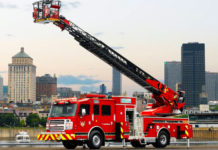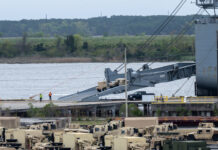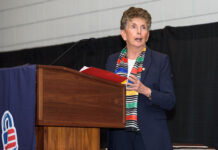Story by Petty Officer 3rd Class Corinne Zilnicki
First, he tugs on a well-worn leather jacket, adjusting the sleeves and closing the zipper with a metallic swish.
Then he laces up his sturdy leather boots, fingers flying deftly through the routine motions.
Once he slips on leather gloves and pulls on his white helmet, Petty Officer 1st Class Terry Hasenauer grasps his handlebars, swings his leg over the seat and mounts his motorcycle.
He is ready to ride.
As he merges into the throng of cars on the highway, his eyes sweep the road from behind shatterproof sunglasses, tracking the vehicles’ movements.
When the road curves left, he shifts to the right of his lane to optimize his view of oncoming traffic. When a truck roars forward to pass him on the right, Hasenauer quickly hugs the left side again, widening the gap.
This choreography comes naturally to him now, but he didn’t always ride so conscientiously.
He learned these proactive measures and more through BikeSafe North Carolina, a motorcycle safety course Hasenauer said is unique in its psychological approach to safety.
“I’ve been riding motorcycles for 21 years,” said Hasenauer. “But BikeSafe changed my entire perspective on riding.”
(Learn how to Ride for your Life. Free motorcycling training, courtesy of BikeSafe North Carolina, NCDOTcommunications and YouTube)
Once he discovered the course, which was modeled after the parent BikeSafe London program, Hasenauer not only enrolled as a student, but applied to become an instructor.
“I went through a very difficult eight-day course,” he said. “We rode for 10 to 12 hours every single day. The instructors pushed and our bikes to our limits.”
Upon graduating from the course on Aug. 19, 2016, Hasenauer was eager to begin sharing the principles of BikeSafe with fellow motorcyclists.
He taught his first class in October of 2016, and began as he now begins every BikeSafe session: by inspecting each student’s motorcycle from headlight to taillight.
“Some of the common issues I’ve found are worn-down tires, leaking fluids and illegal bike modifications,” Hasenauer explained.
After the inspection, the group moves to a classroom where Hasenauer and his fellow instructors impart basic safety principles to students, focusing on how riders can make themselves more visible to inattentive drivers.

“We know drivers are daydreaming, we know they’re rushing to work, we know they’re texting,” said Hasenauer.
“You can equip yourself with high-contrast gear and equip your bike with extra lights, but the most important thing is to make decisions based on the knowledge that they might not see you.”
With these precautions in mind, students and instructors embark on their first road ride.
“We tell the students, ‘Ride your ride,’” Hasenauer said. “We want to see each individual perform naturally so we can effectively critique them.”
Hasenauer said the shortcoming he most often sees while assessing riders on the road is complacency.
“I almost always see riders who get too comfortable and remain in the same lane position the whole ride,” Hasenauer said. “I also see riders underestimate risk. They don’t increase their distance from cars. They take their hands off their handlebars at stoplights.”
After the first ride, the group returns to the classroom where instructors offer students feedback and delve deeper into the psychology of safety.
“We connect the dots between BikeSafe principles and the students’ riding behaviors,” Hasenauer said. “That’s usually when the riders light up with realization and surprise.”
Lt. j.g. Michael Cooper, the operations officer of Coast Guard Cutter Elm and one of Hasenauer’s past BikeSafe students, agreed that the road ride is an invaluable teaching tool.
“I sat down with Petty Officer Hasenauer and talked about my style and what he saw from an outside perspective,” Cooper said. “His insights and comments have drastically changed the way I ride.”
After in-depth consultation, the group hits the road for a final assessed ride.
“During that ride, we want to see students implement the techniques they’ve learned,” said Hasenauer.
“We want to see dynamic movements within the lanes, we want to see clean riding and proactive decision-making.”
Instructors provide one last round of feedback, then dismiss the class to enjoy their shared hobby in a more mindful way.

Chief Petty Officer Anthony Lore, a storekeeper with Coast Guard Sector Field Office Fort Macon and former attendee of Hasenauer’s BikeSafe class, said the course changed his habits for the better.
“I was skeptical at first because this course seemed so different,” Lore said. “But I have seen positive changes in how I ride. I now have the tools to make sure other drivers see me.”
Petty Officer Hasenauer, currently the only Coast Guardsman certified as a BikeSafe NC instructor, has conducted four BikeSafe classes throughout the state so far and said he hopes to see the course grow nationwide.
While the majority of his students are fellow Coast Guard members, he has also instructed several Marines and said he appreciates the opportunities to work with riders in other services.
“There is a strong motorcycle culture throughout the entire military,” he said. “That’s why it’s crucial for me to reach as many service members as possible.”
Hasenauer’s fervor for motorcycle safety and love of riding do not go unnoticed by his students.
“It immediately became clear that motorcycle safety is something Petty Officer Hasenauer is extremely passionate about,” said Cooper. “He did an outstanding job of keeping the class engaged and involved in the lessons.”
Hasenauer said that teaching motorcycle safety perfectly combines his interests, and that he gains great self-satisfaction from positively impacting motorcyclists’ lives.
“It’s more than basic motorcycle safety, it’s survival,” he said. “If we succeed, the outcome is life.”















